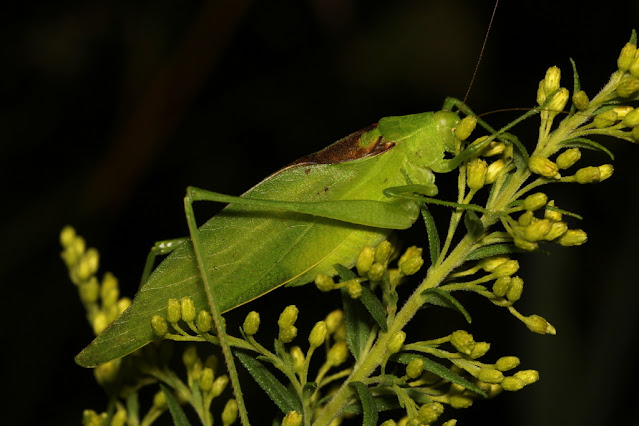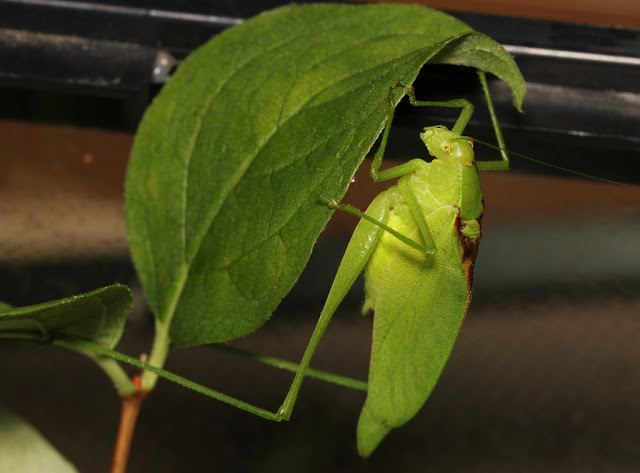My last post was introduced by Sword-bearing Coneheads and included meadow katydids. Their concert halls are meadows and fields.
Tonight, we’re moving to a different habitat. Imagine that our meadow trail is now leading us into the woods.
It’s quite leafy in here, and there’s insect song. But from where?
Just from this photo, you might guess that they would not typically live in an open meadow or field. Did you notice how the wings resemble and blend with the leaves in the previous photo?
Listen – and look – for these katydids in woodlands and edges. They won’t be high up in the trees, so you’ll have a reasonable chance of seeing one if you pay attention to the understory. (Deer browse, however, is a serious problem for many of our woodlands because of deer overpopulation. Where the understory is still intact, there should be katydids and crickets.)
Look closer at this Oblong-winged Katydid’s details, starting with his head. It’s rounded, isn’t it? Compare this to a bush katydid from the genus Scudderia:
The Oblong-winged Katydid is one of the round-headed katydids for obvious reasons.
Bush katydids look like narrow leaves. and most of them will be more common in edge habitats, wetland edges, and in meadows. We’ll look at them in a future post.
The male Oblong-winged has a dark stridulatory field (where the songs are produced). Although one might wonder if the brown is a sign of damage, it is not. This is where his instrument is located. There are varying degrees of brown on the male stridulatory fields of three of the four additional katydid species we'll look at and listen to as well.
Females have a wide, curved, and
rather flat ovipositor, suggesting that ovipositing in a grass or cattail
stem like a meadow katydid is not their plan whatsoever. She typically oviposits in the soil.
And the song? It’s quite different from the Sword-bearing Conehead, whose continuous chugging along reminds many people of a sprinkler.
The Oblong-winged’s song doesn’t resemble the endless tics and whirrs of the meadow katydids.
It’s a short song – just three syllables, though you may only hear the first two if you're farther away. You might even hear the additional little click of his wings opening in preparation for the next song if you're close. After a pause, the song is then repeated. It's fairly loud for those who hear those frequencies well.
Does this song remind you of anyone? What about the Common True Katydid?
The Common True Katydid is the largest of our Ohio katydids. The males of this species have brown stridulatory fields, as do the Oblong-winged Katydids.
This large katydid's song is much lower in pitch, significantly louder, and will consist of just 2 – 4 syllables. It’s often 3, as in Ka-ty-did. (Occasionally, an inspired individual up will even sing 5 syllables in a song.).
Could an Oblong-winged song be considered three syllables? I think so, if you can listen as quickly as the speed at which they sing them.
The Greater Angle-wing is a stunning leaf mimic who lives in trees and can occasionally be heard (and maybe even seen) in large shrubs.
His songs and calls don't quite fit the patterns of the Oblong-winged and Common True Katydids, though they do have recognizable, repeating patterns. They're a series of tics that increase in tempo as their wings get closer together. A pause follows until he’s ready to begin the next song.
But then there’s the Lesser Angle-wing, who is now
beginning to move up into NE Ohio from farther south in the state. I've heard and recorded them in the Cuyahoga Valley National Park in the Peninsula, Ohio area and they have been reported elsewhere in the park.
Listen: a short burst of wing strokes followed by a pause, as if it's related to the Oblong-winged.
The recording below compares the Oblong-winged Katydid (first) to the Lesser Angle-wing (second). There's a slight difference in the sonograms, as the Oblong-winged's song contains soft tics at the beginning that we may or may not be able to hear.
Next, let's look at and listen to the Oblong-winged’s little cousin, the Rattler Round-winged Katydid for similarities.
The Rattler's songs are little groups of rattles: two short groups and one longer rattle.
Rattlers have a look-alike cousin – the Clicker Round-winged Katydid – which appears from its range map to be a possibility for Lorain, Medina, and maybe Summit Counties. I have never found one, though if it were a female or a male who was not singing, I might have assumed it was a Rattler.
A few years ago, I was very fortunate to have spent the late summer all the way through autumn with a Clicker Round-winged Katydid from Wil Hershberger. Wil knew I’d never met one and would want to learn the song. It really is a series of short groups of clicks.
All of these songs are quite different from the Conocephalus and Orchelimum meadow katydids and from the Sword-bearing Conehead. It’s a different ensemble in a very different habitat.
Now about their leaves.
Angle-wings - both Greater and Lesser – and the Common True
Katydids live up in the trees. Oblong-wingeds and Rattlers will be in the
understory. It’s quite easy to hide in the leaves if one looks like a leaf, and
katydids are certainly masters of camouflage.
I seldom see Oblong-wingeds or Rattlers during the day. After dusk, the males will sit on the upper surfaces of leaves and sing.
Rattler Round-winged Katydid male on display. Perhaps a female will be impressed.
Male Oblong-wing looking quite gorgeous.
Look carefully: you may also see a female surveying her admirers from her own leafy throne. I have seen a single female looking quite regal while surrounded by a number of singing males.
I emphasized in my previous post that the meadow katydids and Sword-bearing Coneheads are enthusiastic seed-eaters.The featured insects of this post not only live in leaves but also feast on them. Let’s take yet another look at the Oblong-winged, as he is the katydid who introduced this post.
I currently have an Oblong-winged Katydid in a mesh butterfly cage at home. He absolutely skeletonizes the blackberry leaves I provide for him. He receives Romaine lettuce, a little slice of apple (which I’ve seen him sample), and a half a grape on his daily produce kabob sticks, but his primary diet is the blackberry leaves in which he hides and from which he sings.
Top: blackberry leaves in a woodland Oblong-winged habitat.
Below: Oliver Oblong-winged has begun to dine on his newest
blackberry leaves in his singing cage.
My Rattler-Round-winged Katydid, Clicker Round-winged Katydid, and Lesser Angle-wing from previous years were leaf mimics and leaf eaters as well, and I expect this would also be true for the Greater Angle-wing.
Lesser Angle-wings eat the leaves in which they live.
Clicker Round-winged Katydid male at his salad bar.
So listen first, as they are often quite challenging to locate visually in the woods at night. Notice the song similarities between species that share the same habitat. If, with patience, you find a singing male or nearby female, marvel at how much they look like the leaves in which they live and on which they dine.
I often say that “a meadow doesn’t sound like a woodland” when I’m talking about birdsong and habitat. Similarly, grouping insect songs together by habitat is easier than trying to remember a lengthy collection of unrelated tics, whirrs, and trills. Even more rewarding is listening to the music of a particular concert venue and knowing who the musicians are and cherishing the interplay of their instruments.
And, of course, we need to protect all the katydid and cricket concert halls to ensure the music continues!

































No comments:
Post a Comment